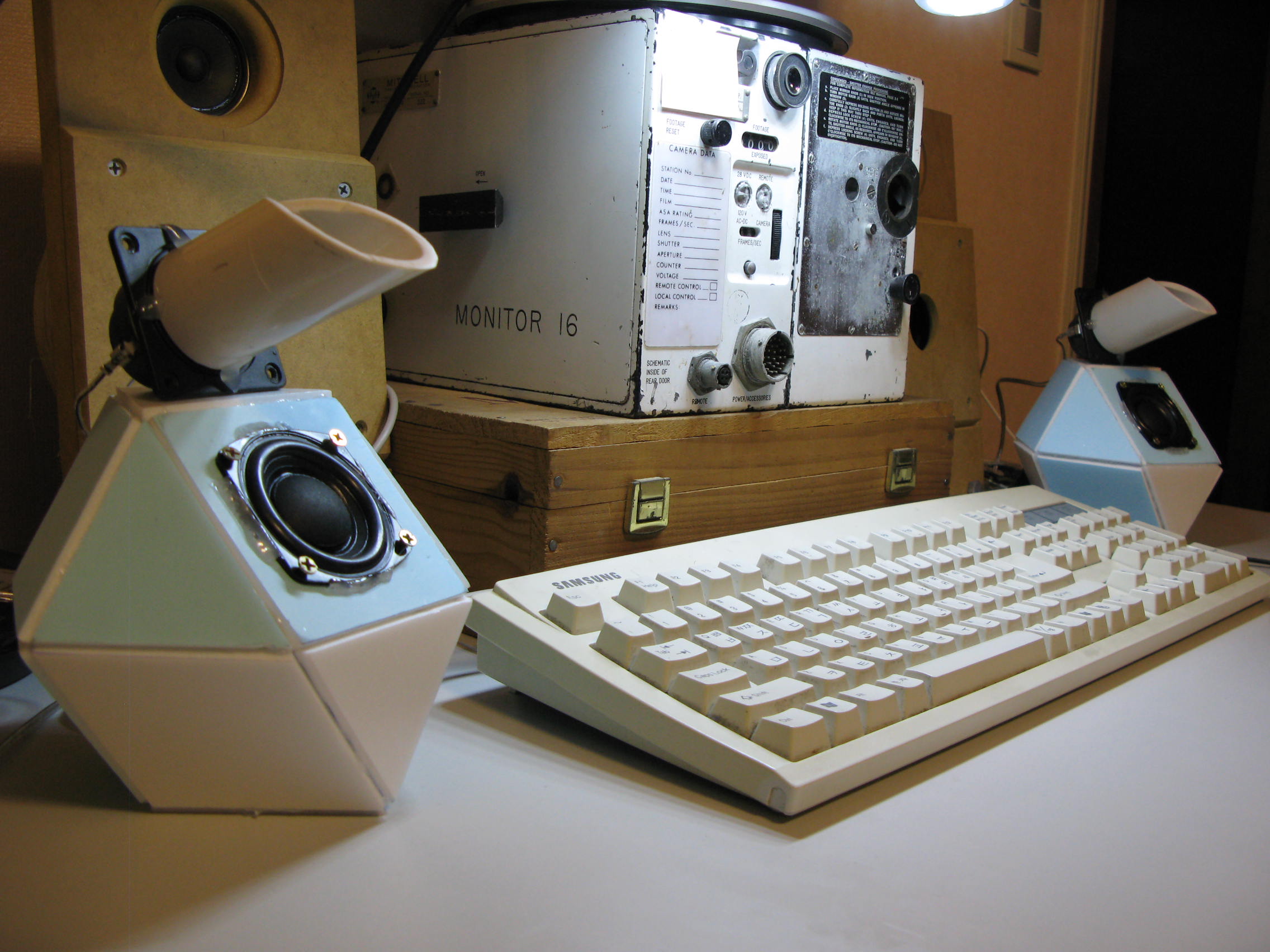Derek, I had seen those papers before, nice read. But seeing you hammer down the point of fast transients I have to raise this question: Why would you build line arrays? The straight line array always has a build in time smear (yes, I'll admit to that even though I'm building arrays too) due to drivers being not equal distance to the ear.
Fellow Manger fan....!
Hi Cornelis,
Glad you liked my post, I was beginning to think I was alone in temporal world of time domain accuracy....!!
We are both lucky guys.....We both got to visit Joseph Manger at home and hear his reference system....Isn't he (and Daniela) an amazing guy?!
My German is poor, his English was good, but Daniela did most of translation.
I met them a few times between 2001 and 2005, when the High End shows were held in the Kempinski Hotel in Munich.
JW also is a fan of the Manger driver.
Since 2009 I have been focused on making my own version of the BMR...Basically a baby Manger at a fraction of the cost.
If you are ever up in my neck of the woods (Cambridge) it would be great to get a fellow Manger fans opinion of my BMR....I still have a pair of Mangers for reference and I am very happy with the results.
Rather than take up more of this threads valuable subject space I am happy to PM and then email more info on this subject.
I have tried opening various threads on this site before, but there are so many vested interests and trolls who have to denounce anything other than their own products / ideology that’s its not worth the effort...
All the best
And spk soon
Derek.
All natural sounds are produced using one method….One clean near instantaneous transient with rapid decay back to ambient, this is the only way we hear sound….This is also the only way to reproduce natural sounds.
Thank you Overkill. You have made a very important point. The articles you gave links to are the best explanantions of the workings of the ear I have ever come across.
Our ears and brain are evolved to hear the snapping of a twig when a tiger is creeping up behind your back.
I have had an opportunity to visit Joseph Manger in his living room. His speakers did something for me that I have never heard from other speakers not only on his stereo speakers did the orchestra show breadth, but there was also a clear hint of depth, where there was the effect of players sitting in front and behind each other. Not only that, his system had a very large "sweet spot".
If these speaker hypercube enclosures could be shown to improve the phase response of the speaker system and a spatial effect better than conventional rectangular boxes, we could be making some real progress.
I wish I had some time to explore this notions in greater detail.
Hi Cornelis,
Glad you liked my post, I was beginning to think I was alone in temporal world of time domain accuracy....!!
We are both lucky guys.....We both got to visit Joseph Manger at home and hear his reference system....Isn't he (and Daniela) an amazing guy?!
My German is poor, his English was good, but Daniela did most of translation.
I met them a few times between 2001 and 2005, when the High End shows were held in the Kempinski Hotel in Munich.
JW also is a fan of the Manger driver.
Since 2009 I have been focused on making my own version of the BMR...Basically a baby Manger at a fraction of the cost.
If you are ever up in my neck of the woods (Cambridge) it would be great to get a fellow Manger fans opinion of my BMR....I still have a pair of Mangers for reference and I am very happy with the results.
Rather than take up more of this threads valuable subject space I am happy to PM and then email more info on this subject.
I have tried opening various threads on this site before, but there are so many vested interests and trolls who have to denounce anything other than their own products / ideology that’s its not worth the effort...
All the best
And spk soon
Derek.
Hi,
"
All natural sounds are produced using one method….One clean near instantaneous
transient with rapid decay back to ambient, this is the only way we hear sound….
This is also the only way to reproduce natural sounds."
Complete and utter nonsense, clueless, uneducated, drivel.
The reality is far more complicated and far more interesting.
As it always is comparing dogma to the brilliant light of reality.
rgds, sreten.
Strangely enough, I agree 100%. This discussion has gotten completely sillly. Heisenberg? really?! 🙄
Sound is a waveform. Reproduce the waveform, and you have reproduced the sound. That's all there is to it.
Well, I suppose there's the issue of reproducing the 3D form of soundwaves in a given space with a stereo approximation, but that's another subject.
Derek, I had seen those papers before, nice read. But seeing you hammer down the point of fast transients I have to raise this question: Why would you build line arrays? The straight line array always has a build in time smear (yes, I'll admit to that even though I'm building arrays too) due to drivers being not equal distance to the ear.
Hi Wesayso,
Good to see you here, I have been following your astonishing line array journey....So much more than just a build, and your latest design looks stunning!
Your point is a good one and not too off topic as stacks or arrays of Hyper Cubes with BMR's would be stunning visually and acoustically....
To be specific and answer your question :
(1) Lesser of many evils.
(2) Benefits far out weigh the drawbacks
(3) The problem you mention is far worse with conventional drivers than with BMR's.
To expand a bit more, and please forgive me preaching to the converted...!
When you finally get your amazing speakers finished and all tuned up, the sound of your arrays will crush the sound of a pair of the drivers used as a point source.
Why?
The most important contributing factor is :
(1) Because, for any given SPL, 20 times the drivers = a 20th of the cone movement. This means all the horrible "ghost echoes" ( see my previous few pages of posts) or time domain distortion is reduced by a factor of 20!
(2) With a tall array (over 75% of the floor to ceiling height) mounted on or in the wall you get huge room boundary benefits:
Bass and lower midrange reinforcement, distributed bass, elimination or massive reduction of baffle step issues, elimination or massive reduction of cabinet diffraction, elimination or massive reduction of floor and ceiling bounce.
(3) With enough drivers ( Sd) you dont need a sub for music. Always need two or three for home cinema.
(4) Unique benefits of my particular BMR:
(5) The ideal power response floods the room with a 160 degree even frequency response in both vertical and horizontal planes.
This results in a broad and balanced series of room reflections (mostly side walls) which mimick the natural room reflections of natural sound sources.
Not just a sweet spot, a sweet room! Even outside the main listening room, even folks outside the house walking in the garden comment on how completely natural and lifelike the sound is.
The accumulated benefit of the BMR power response when used on wall and in line arrays is the total and elimination of any audible comb filtering when playing music and listening at more than 80cm to 1 meter distance.
Comb filtering is only measurable at very close distances ( under 60 cm) and only audible at even closer distances.
The reason is simple: Its the ratio of the path length difference to the total listening distance that defines if any interference is audible. In real rooms, at real listening distances ( 2 meters or more) the tiny path length differences from ear to driver(s) are inaudible and also swamped by an infinite number of room reflections.
Importantly, try to imagine the air pressure graphic posted by Tesserac...The deciding factor in how the ear brain decides " Is it real or is it hifi?" is the clean transient and decay.....These key pressure points are rendered so accurately that we regard them as real.
As long as the drivers are in phase, there is no comb filtering of the compression / rarefaction ....Only sine waves suffer from comb filtering.
The tiny ratio of path length difference to listening distance is not enough to affect the phase from one cone to to the next.
I hope this makes more sense and helps answer your question....Sorry to ramble on so much but its worth it when you hear it!
Cheers
Derek.
Sorry Greg, I believe you are wrong!
Hi Greg,
Now I see....When you quoted the sretin I can see what he wrote....Surprise surprise....Well as Ricky Gervais recently said "2 wrongs don't make a right" or something like that anyway😀
If You do really believe " Sound is a waveform. Reproduce the waveform, and you have reproduced the sound. That's all there is to it. "
Then carry on and enjoy the music.
All the best
Derek.
Strangely enough, I agree 100%. This discussion has gotten completely sillly. Heisenberg? really?! 🙄
Sound is a waveform. Reproduce the waveform, and you have reproduced the sound. That's all there is to it.
Well, I suppose there's the issue of reproducing the 3D form of soundwaves in a given space with a stereo approximation, but that's another subject.
Hi Greg,
Now I see....When you quoted the sretin I can see what he wrote....Surprise surprise....Well as Ricky Gervais recently said "2 wrongs don't make a right" or something like that anyway😀
If You do really believe " Sound is a waveform. Reproduce the waveform, and you have reproduced the sound. That's all there is to it. "
Then carry on and enjoy the music.
All the best
Derek.
Hi,
Only goes to prove you can build stuff without a real clue what is going on.
And get some pointless peurile kick out of offensively mispelling my name.
Which says it all about integrity.
rgds, sreten.
Only goes to prove you can build stuff without a real clue what is going on.
And get some pointless peurile kick out of offensively mispelling my name.
Which says it all about integrity.
rgds, sreten.
Last edited:
" The ear works in two distinct ways, which it moves between in order to obtain the best outcome
from the fundamental limits due to the Heisenberg inequality. The Heisenberg inequality states
that as frequency resolution goes up, time resolution goes down and vice versa.
This is incorrect. In sound (a classical phenomenon), frequency and time are not quantum conjugate variables, i.e., they commute. Heisenberg only applies to conjugate variables in QM, which are not encountered in the classical limit.
You might be thinking about Fourier uncertainty, which only loosely applies to hearing; some recent papers about this have been discussed here in the past several months.
edit: There's some very nice articles available about the Gabor limit. It also applies in QM, but Fourier conjugates are, in this case, classical.
Sound is a waveform. Reproduce the waveform, and you have reproduced the sound. That's all there is to it.
This is 100% correct. Otherwise, one is getting into the paranormal (and pataphysical!) realm.
All natural sounds are produced using one method….One clean near instantaneous transient with rapid decay back to ambient, this is the only way we hear sound….This is also the only way to reproduce natural sounds.
Ah, this explains why I can't hear wind...
Oh, wait a minute, I can hear wind!
Oh, wait a minute, I can hear wind!
To be fair, you don't actually hear wind, you hear the sounds of wind exciting higher frequency phenomena.
To be fair, you don't actually hear wind, you hear the sounds of wind exciting higher frequency phenomena.
Two monks were watching a flag flapping in the wind. One said to the other, "The flag is moving."
The other replied, "The wind is moving."
Huineng overheard this. He said, "Not the flag, not the wind; mind is moving."
Sorry, I couldn't resist. But I do think that the elephant in the room here is mind.
Please post any links if available?
Thanks Sy,
You are losing me here, but it sounds like an interesting debate, please post any recommended links, esp to the Gabor limit.
Thanks in advance
Derek.
edit: There's some very nice articles available about the Gabor limit. It also applies in QM, but Fourier conjugates are, in this case, classical.
Thanks Sy,
You are losing me here, but it sounds like an interesting debate, please post any recommended links, esp to the Gabor limit.
Thanks in advance
Derek.
You are losing me here, but it sounds like an interesting debate, please post any recommended links, esp to the Gabor limit.
The Wikipedia entry on time-frequency analysis is actually quite good:
Time?frequency analysis - Wikipedia, the free encyclopedia
And the Physical Review letter about the relationship to hearing and pitch may be found here (though you'll need to either buy the paper or go to a library to read it):
Phys. Rev. Lett. 110, 044301 (2013) - Human Time-Frequency Acuity Beats the Fourier Uncertainty Principle
Xrk: Aaaaargh!!!
Those tubes are insulting !
( foam core either, but that's another matter ...)
Those tubes are insulting !
( foam core either, but that's another matter ...)
In previous posts and their links there was a continual reference to saying that sine waves contain no information as a point to espouse the importance of time accurate impulse response function. This may be true for a continuous sine wave but switch them on and off and have 32 different frequency sine waves represented just as a Fourier coefficient for each frequency bank and you have MP3. Plenty of information there as billions of people can tell you when they listen to music everyday.
The Wikipedia entry on time-frequency analysis is actually quite good:
Time?frequency analysis - Wikipedia, the free encyclopedia
Thanks, Sy. That is a good read.
RS100-4's arrived
The Dayton RS100-4's that Byrtt was kind enough to provide arrived today. They are really nice: super high quality build - very pretty with alloy frame and anodized aluminum cone and phase plug. Thank you Byrtt! 🙂
Very nice looking and feels like quality:
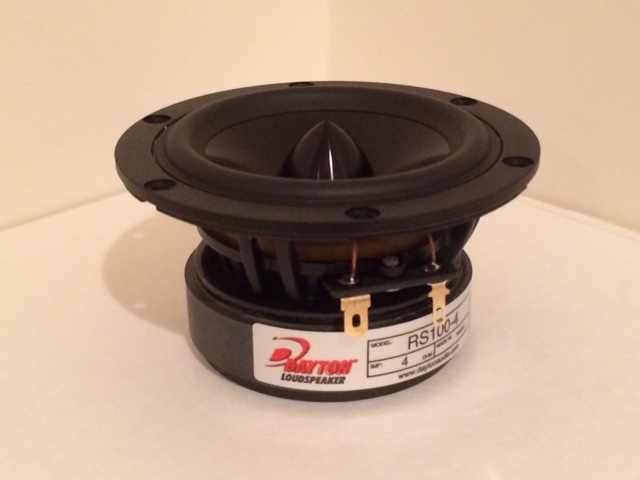
Before installing them in the Hypercube I took another spectrum with the TC9FD. Without touching the mic, I swapped out the drivers (drop in replacement - cutout was a tad tight since magnet is much bigger) without moving anything. I then retook the spectrum at the same settings. The results show that both of these drivers are remarkably similar in behavior with a few differences: the TC9FD has more of a rising response and is smoother in the upper registers above 10kHz. This plot also says that most of the dips and peaks are caused by the room, or cabinet diffraction.
Installed in Hypercube:

Freq response of TC9FD (blue) and RS100-4 (red) - these were both driven at the same level and mic distance (0.50 meter) yet they appear to have same sensitivity even though the RS100-4 (4ohms) should be higher at same voltage as an 8ohm driver. I am very surprised how similar these drivers are. You can see that the RS100 has a larger breakup mode near 15kHz - that will show up as ringing in the impulse response. RS100-4 has improved bass response and seems to be flatter in the mid bass region:
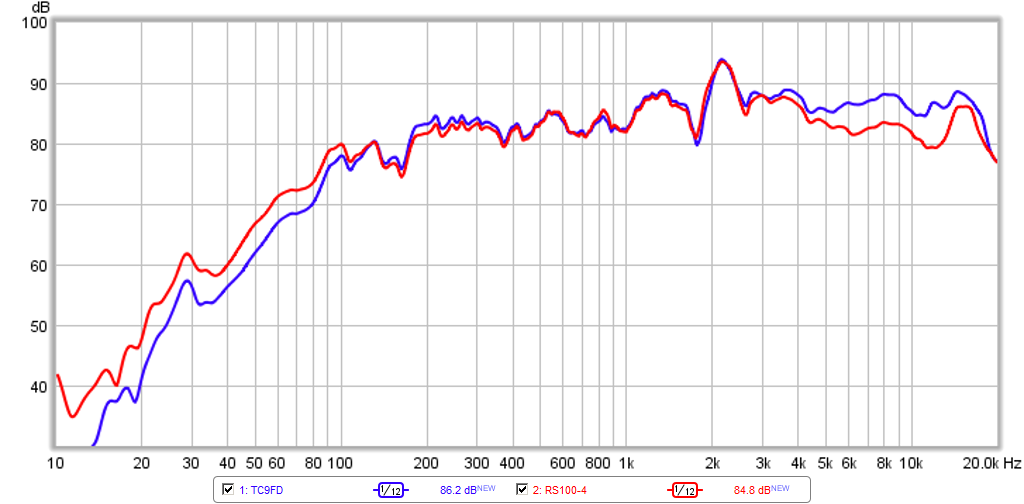
Here is the measured impulse response from the TC9FD:
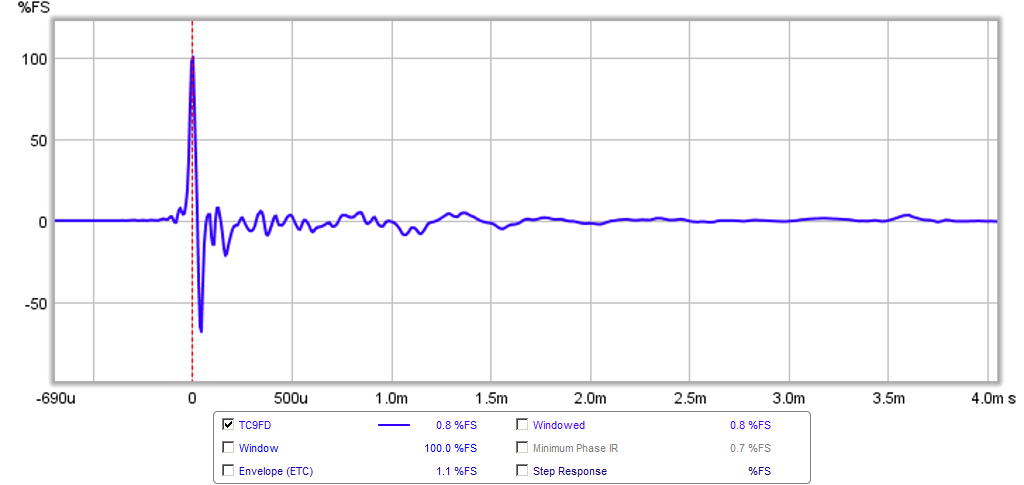
Here is the measured impulse response of the RS100-4:
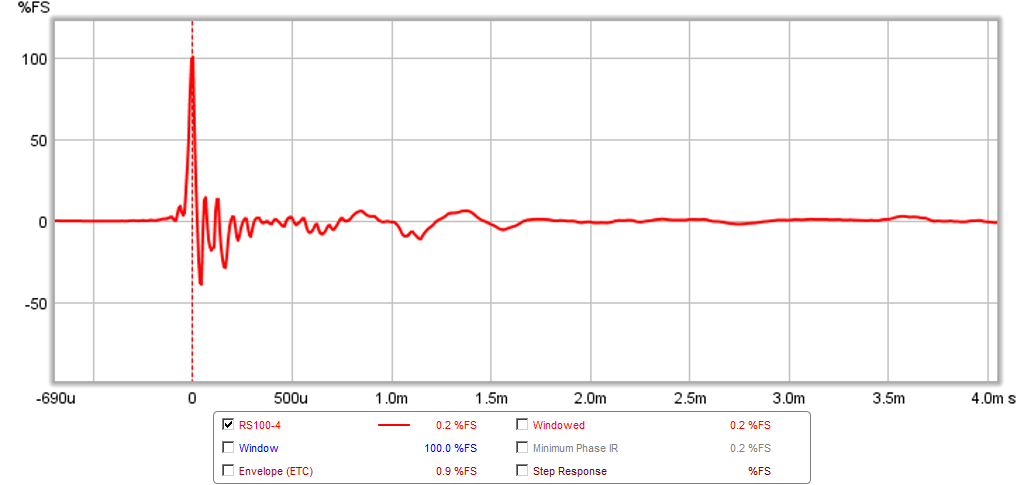
Here is the HD of the RS100-4:
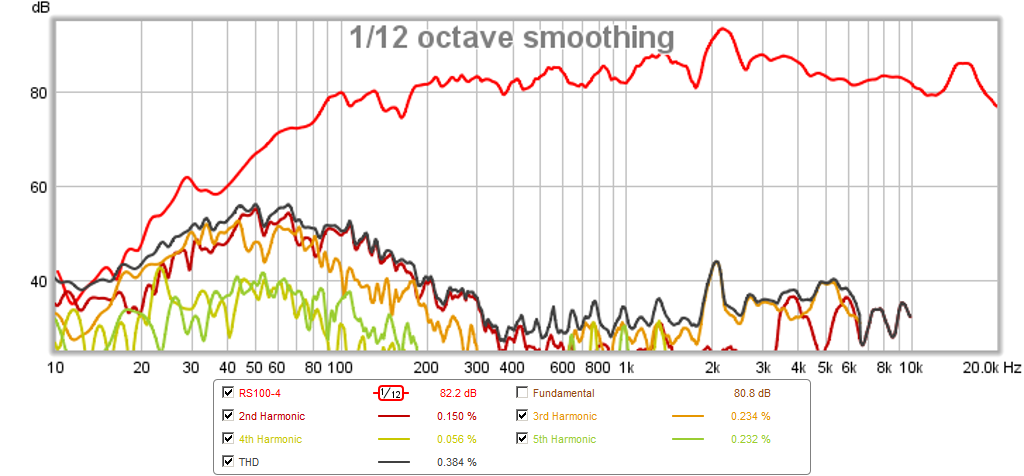
Here is the HD of the TC9FD:
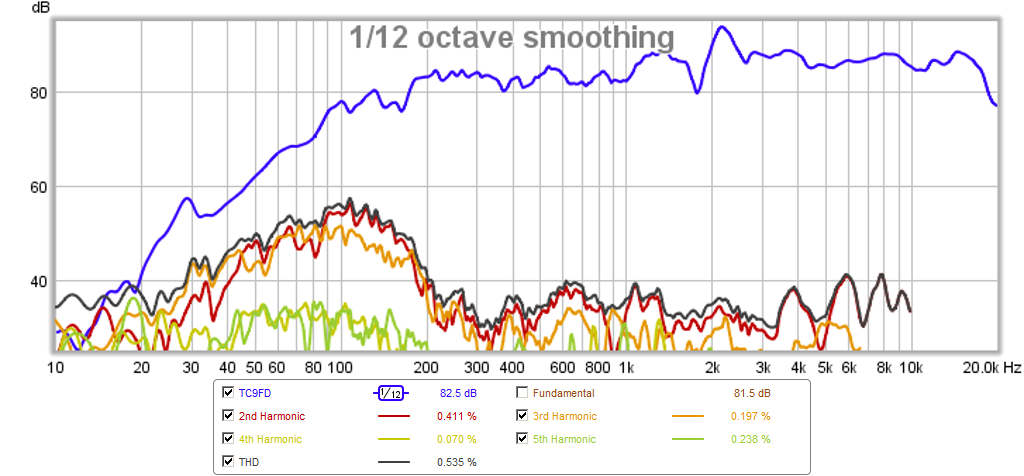
The Dayton RS100-4's that Byrtt was kind enough to provide arrived today. They are really nice: super high quality build - very pretty with alloy frame and anodized aluminum cone and phase plug. Thank you Byrtt! 🙂
Very nice looking and feels like quality:

Before installing them in the Hypercube I took another spectrum with the TC9FD. Without touching the mic, I swapped out the drivers (drop in replacement - cutout was a tad tight since magnet is much bigger) without moving anything. I then retook the spectrum at the same settings. The results show that both of these drivers are remarkably similar in behavior with a few differences: the TC9FD has more of a rising response and is smoother in the upper registers above 10kHz. This plot also says that most of the dips and peaks are caused by the room, or cabinet diffraction.
Installed in Hypercube:

Freq response of TC9FD (blue) and RS100-4 (red) - these were both driven at the same level and mic distance (0.50 meter) yet they appear to have same sensitivity even though the RS100-4 (4ohms) should be higher at same voltage as an 8ohm driver. I am very surprised how similar these drivers are. You can see that the RS100 has a larger breakup mode near 15kHz - that will show up as ringing in the impulse response. RS100-4 has improved bass response and seems to be flatter in the mid bass region:

Here is the measured impulse response from the TC9FD:

Here is the measured impulse response of the RS100-4:

Here is the HD of the RS100-4:

Here is the HD of the TC9FD:

Attachments
-
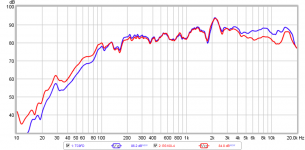 hypercube-rs100-tc9fd-freq-10db.png73.2 KB · Views: 787
hypercube-rs100-tc9fd-freq-10db.png73.2 KB · Views: 787 -
 hypercube-rs100-ir.png42.8 KB · Views: 456
hypercube-rs100-ir.png42.8 KB · Views: 456 -
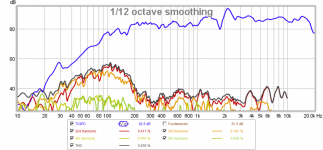 hypercube-tc9fd-hd.png145.2 KB · Views: 476
hypercube-tc9fd-hd.png145.2 KB · Views: 476 -
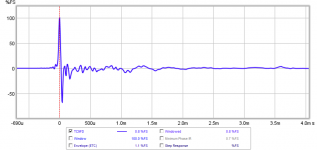 hypercube-tc9fd-ir.png45.4 KB · Views: 476
hypercube-tc9fd-ir.png45.4 KB · Views: 476 -
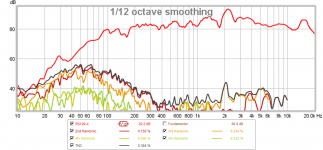 hypercube-rs100-hd.png143.7 KB · Views: 464
hypercube-rs100-hd.png143.7 KB · Views: 464 -
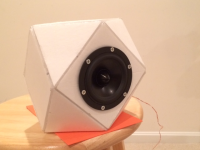 RS100-4-hypercube.png346.5 KB · Views: 470
RS100-4-hypercube.png346.5 KB · Views: 470 -
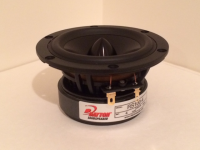 RS100-4-bare.png336 KB · Views: 472
RS100-4-bare.png336 KB · Views: 472
Last edited:
- Status
- Not open for further replies.
- Home
- Loudspeakers
- Full Range
- Hypercube Loudspeakers
